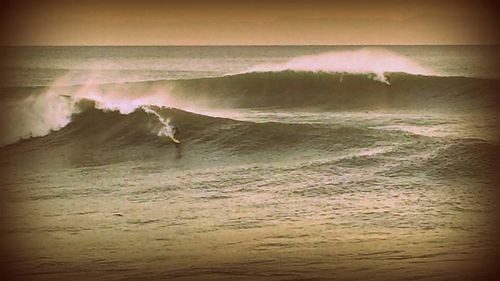The Lazy Days.
Have A Great Weekend!
Have A Happy Fourth of July!
Dude, Who's The New Big Guy In The Lineup? (Moving Pictures)
[youtube http://www.youtube.com/watch?v=tOFwNzKl13c]
They're going to have a whale of a tale to tell.
Via Thad.
Fog Again!
The Alaskan current brings down the cold water, the marine layer encounters the colder waters from Alaska, it cools to its dewpoint, and hello fog. Add to the mix a difference in pressure, a hot Central Valley, the prevailing winds, a funnel called the Golden Gate, and before you can say "Bob's your Uncle," Mr. Fog shows up.
Monday Morning Mermaid.
Have A Great Weekend!
Fish On Fridays.
Friday Flyover.
Surfing Photo Of The Day.
Summer In San Francisco.
Throwback Thursday. "Frank Dye Crosses The Norwegian Sea In Wayfarer Dinghy"
[youtube http://www.youtube.com/watch?v=NZ9Qh9hv8eQ]
The film above documents Frank Dye's second major sea passage, a Norwegian Sea crossing from Scotland to Aalesund, Norway, Dye and his crew, Bill Brockbank, narrowly survived four capsizes and a broken mast during a Force 9 storm. In Ocean–Crossing Wayfarer (1977), written with his wife Margaret, Dye recalled the scene: "It was impossible to look into the wind. It was screaming and the tops of the waves were blown completely away, feeling like hail. Within our limited vision the whole sea seemed to be smoking. Just to see such seas break away on the beam was frightening – 25ft of solid water, with another 12ft of overhanging crest above it. It was only a matter of time before we got one aboard."
When the inevitable happened, both men hauled on the warps, frantically trying to pull Wanderer through the crest: "She rose gallantly, but it was an impossible position: she seemed to be rising at 60 degrees and there was still a 15ft crest curling above us. Down it came and we were driven bodily under. With ears roaring under immense pressure, and swallowing water, I fought back to the surface, only to find Wanderer was lying bottom up."
After three more capsizes, Dye reflected: "Possibly we were the only people alive to have taken an open dinghy through a Force 9 gale, but we felt no elation, just a reaction of wetness, coldness and extreme tiredness." The pair recovered the mast from the sea, made a jury rig and went on to make landfall in Norway without further incident.
Weekday Wahine.
Wayback Wednesday.
Where are we going today Mr. Peabody? Sherman, we are travelling back to 2011 to see for ourselves why it's not a good thing to play chicken with a ship in a channel.
Munchola!
Ah-oh, mast fall down and go boom.
[youtube http://www.youtube.com/watch?v=_tUoUxzt9sI]
Fall off, fall off...too late! Nice sail shape.
Former Naval officer and skipper of the Atalanta of Chester, Ronald Wilson and his crew of serving or former Royal Navy personnel managed to collide with the tanker ship, Hanne Knutsen. The yacht's highly experienced crew - which consisted of serving and retired Royal Navy officers - had failed to correctly anticipate the tanker's movements. Do tell! A big red ship, balsting it's horn and sailing up a narrow channel, damn near impossible to tell where it's going.
Hubris is not a good thing.
Wednesday Wipeout! (Moving Pictures)
[youtube http://www.youtube.com/watch?v=7APNI_JQ7AM]
Air sponge!
Surf Snips One. (Moving Pictures)
[youtube http://www.youtube.com/watch?v=BRdidjB6lHc]
In the green room.
Cross-pollinated at the water channel.
Sailing Photo Of The Day.
Photo of Team Hafren sailing their Wayfarer dinghy with Peel Castle in the background.
Photo by Charlene Howard.
Team Hafren is made up of two sailors, Phillip Kirk and Jeremy Warren, from Thornbury Sailing Club in Gloucestershire, UK. The team set sail on Saturday May 31st with the aim to sail an open boat around mainland Britain in record time. The current best is 76 days and the target is 60 days. They intend to demonstrate self-sufficiency and good seamanship, and in the spirit of sailing adventurer Frank Dye (1928-2010), reaffirm that a Wayfarer dinghy can undertake extended offshore passages safely. Phil and Jeremy seek to foster good will between sailing clubs and leave a trail of TSC pennants in clubhouses around Britain.
The direct distance is 1500 miles and the plan is for approximately ten hops of 200 miles. Each “hop” is three days, with two nights spent at sea. Going clockwise from Weymouth, up the Irish Sea, west of the Isle of Man, they’ll drop into Northern Ireland (mission accomplished) then off up the west coast of Scotland (they're currently sailing in the Inner Seas off the West Coast of Scotland). This will take in the formidable headlands of Cape Wrath and Duncansby Head, sandbanks of the Thames Estuary, and the familiar headlands of the south coast.
To learn more about the challenge and to follow Team Hafren's progress go to their website or facebook page.
Happy Flag Day!
What Did You Do This Past Weekend?
Go sailing or swimming?
I do see sails ..... in the water, Baydog. But, I wouldn't call it sailing. Chesapeake defined!





















